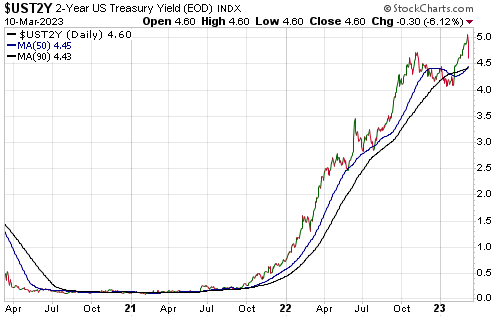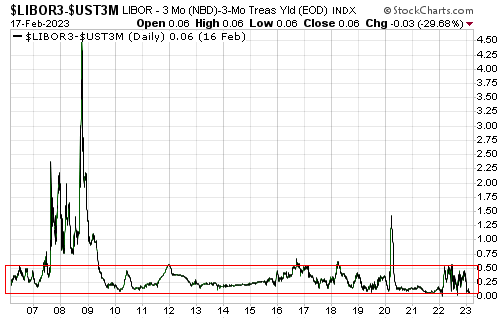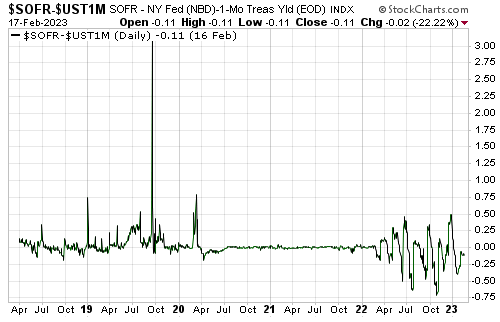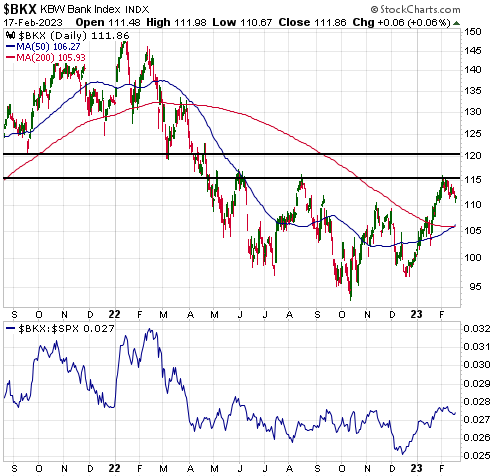[This blog post is an excerpt from a commentary published at TSI last week]
The senior central banks (the Fed and the ECB) hiked their interest rate targets over the past several days and have stated that more rate hikes will be needed to quell the inflation that they, themselves, created*. However, the pressure to stop hiking and to start cutting is building and probably will continue to do so over the next few months. This is important for most financial markets and is especially important for the gold market.
A problem facing the central banks is that they can ‘ring fence’ the banking industry, especially in the US where the major banks are in good financial shape, but they cannot protect the entire financial system without turning from monetary tightening to monetary loosening. Of particular relevance, whereas the banking system is mostly transparent (from the perspective of central banks) and can be supported by targeted measures such as the new Bank Term Funding Program (BTFP), many transactions in the so-called “Shadow Banking System” involve counterparties that are not subject to bank regulations and occur outside the central banks’ field of view. The best example is the Repo (Repurchase Agreement) market, which should not be confused with the Fed’s Reverse Repo facility.
Whereas the Fed’s Reverse Repo facility is well defined in terms of size (currently about US$2.3 trillion) and participants, and is of course within the Fed’s control, the Repo market is even bigger (we are talking multi-trillions of dollars of transactions per day) and involves hedge funds and corporations as well as various financial institutions (banks, MMFs, primary dealers, brokers, pension funds, etc.). A Repo is simply a transaction in which one firm sells securities (typically Treasuries) to another firm and agrees to buy the securities back at a slightly higher price in the future (typically the next day). The difference between the sell price and the buy price is known as the “repo rate”, which effectively is an interest rate. Normally the repo rate is very close to the Fed Funds Rate.
The Fed was forced to intervene in the Repo market in September-2019 to address a liquidity crunch that caused short-term interest rates to spike well above the Fed’s target, and again in 2020 in reaction to a sudden cash shortage caused by the COVID lockdowns. It did this by expanding its balance sheet and creating money out of nothing — a moderate amount of money in reaction to the September-2019 cash crunch and a massive amount of money in reaction to the lockdowns. Most of the time, however, the Repo market just chugs along in the background like the plumbing system that distributes water around a large commercial building.
In a nutshell, the problem for the senior central banks is that while the commercial banking system can be prevented from blowing up while monetary tightening continues, the monetary tightening eventually will lead to blow-ups among other financial operators that are big enough to disrupt the workings of the financial system. The specific major blow-ups usually can’t be identified ahead of time, but if the tightening continues they will happen (actually, there already has been more than enough tightening to set the scene for such events). And when they happen they will not only stop the central banks from doing additional rate hikes, they probably will result in emergency rate cuts and balance-sheet expansions.
The above comments are in the gold section because this is the stuff that really matters for gold. Gold is not the anti-dollar, as it is sometimes labelled. It is also not a hedge against inflation, although like many other ‘hard’ assets it has retained its value over the very long-term. Instead, it is reasonable to think of gold as the anti-bank or the anti-financial-system. As a result, gold’s price is driven by confidence in the financial system and the main official supporters of the financial system (the government and the central bank), which can be quantified to a meaningful extent using certain ratios and interest-rate spreads. Falling confidence leads to a higher valuation for gold, rising confidence leads to a lower valuation for gold.
*That’s not exactly what they are saying, in that they are not accepting blame for the inflation problem. They are saying that more rate hikes are needed to quell the inflation that has arisen due to exogenous and unforeseeable forces.
 Print This Post
Print This Post




